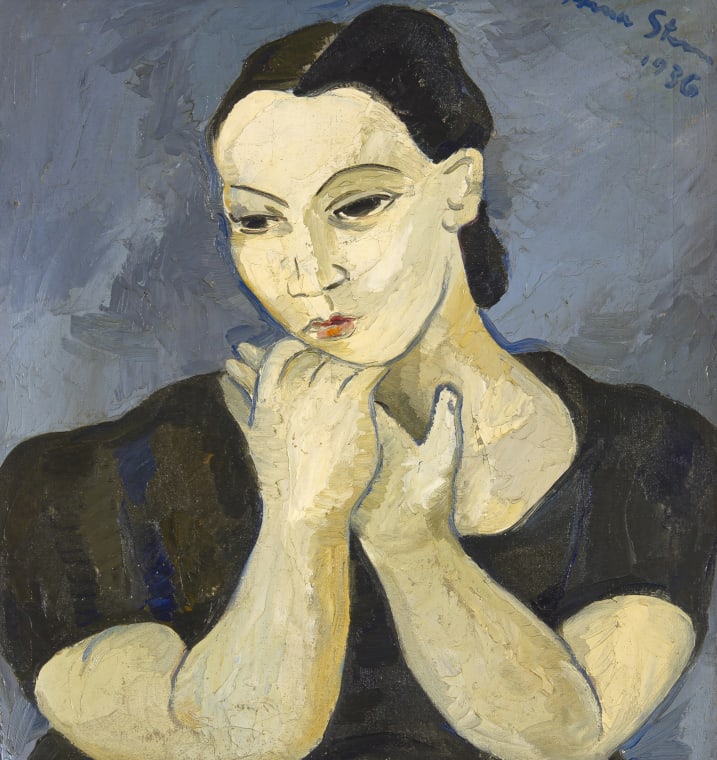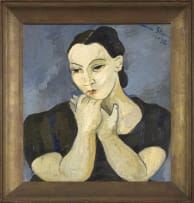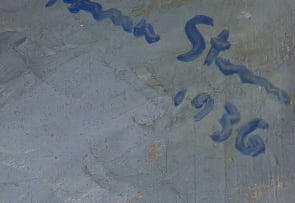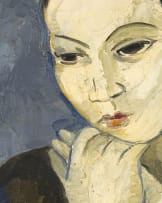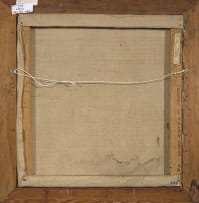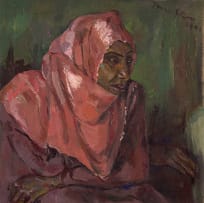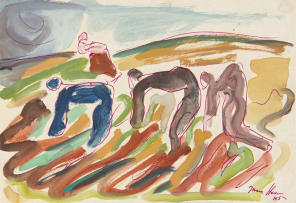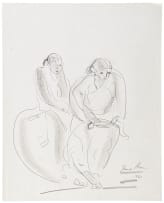Irma Stern: Time|Line
Live Virtual Auction, 8 June 2022
Irma Stern: Time|Line
About the SessionIncl. Buyer's Premium & VAT
About this Item
signed and dated 1936; inscribed with the title, the date and the accession number on the reverse
Notes
Wolf Kibel is quoted as jokingly telling Lippy Lipshitz that Stern suffered from an "art fever" called "Pechsteinism" in reference to the dominating influence of Max Pechstein on her early work.1 While the sources and influences of Stern's art were thoroughly German, Expressionism - the art and literary movement that imprinted itself on a young Stern - did not occur in a vacuum. Its innovations were built on earlier advances in European painting, notably by postimpressionists like Paul Gauguin, Vincent van Gogh and Paul Cézanne. Stern paid close attention to these artists.
In a 1937 letter to Freda Feldman, Stern described herself as equal to Gauguin and Van Gogh, but not Cézanne who, like Stern, is celebrated for his use of thick layers of colour pigment to build his forms. "He has painted pictures so free and so unhampered of the world - of the flesh," wrote Stern.2 Critics similarly recognised the influence of Cézanne. Edward Roworth, a fierce early critic of Stern, invoked Cézanne in his 1937 opening remarks for a Stern exhibition in Cape Town. He praised her choice of painterly challenges of "modelling and gradation" over the "facile modernity of stunt painting", which included surrealism.3
This study of an unknown sitter shares with Cézanne's many portraits of his wife, Hortense Fiquet, the lack of intricate detail. But the voluptuous proportions and pose of the woman in this composition also bear some resemblance to the women from Pablo Picasso's Neoclassical period (1915-25), which saw him set aside the angular planes and fragmented forms of his earlier Cubist period in favour of harmony, simplicity and proportion. Little has been written about Stern's relationship to Picasso and his work.
The two artists were near contemporaries. Born a decade before Stern, in 1881, Picasso died in the decade after her, in 1973. Despite obvious formal differences in their art, both artists were
steeped in the tradition of primitivism. Both artists were also committed to the genre of the nude throughout their careers. And both artists had German-language art monographs issued in
the Junge Kunst ("Young Art") series in 1927, Picasso preceding Stern. The artists briefly met in 1950, when Stern visited Picasso's studio in a former perfumery in Vallauris, near Cannes. "He was a study in concentration, as still as a rock and working with not a wasted motion," Stern recounted afterwards.4
The period in which this work was painted was a transitionary one. Stern shortly arrived at her mature style of descriptive expressionism, in which exquisitely layered colour and expressive
brushwork evocative of Cézanne and Eugène Delacroix came to dominate her portrait studies.
1. D R Betram (1994) Cecil Higgs, Close Up: A Biography, Rivonia: William Waterman Publications, page 34.
2. Mona Berman (2003) Remembering Irma, Johannesburg: Double Storey, page 54.
3. Author unknown (1937) 'An Artist of Integrity', Cape Times, 11 February.
4. Author unknown (1950) 'Irma Stern Home', Cape Times, 4 September.
Provenance
The Irma Stern Trust Collection, accession number 634.
Exhibited
Johannes Stegmann Art Gallery, Bloemfontein, Irma Stern, Early Works (1908-1939), 27 January to 26 February 1993, illustrated in the exhibition catalogue in black and white on page viii.
Literature
Marion Arnold (1995) Irma Stern: A Feast for the Eye, Cape Town: Fernwood Press for Rembrandt Van Rijn Art Foundation, illustrated in a colour photograph of Irma Stern's studio on page 8.
